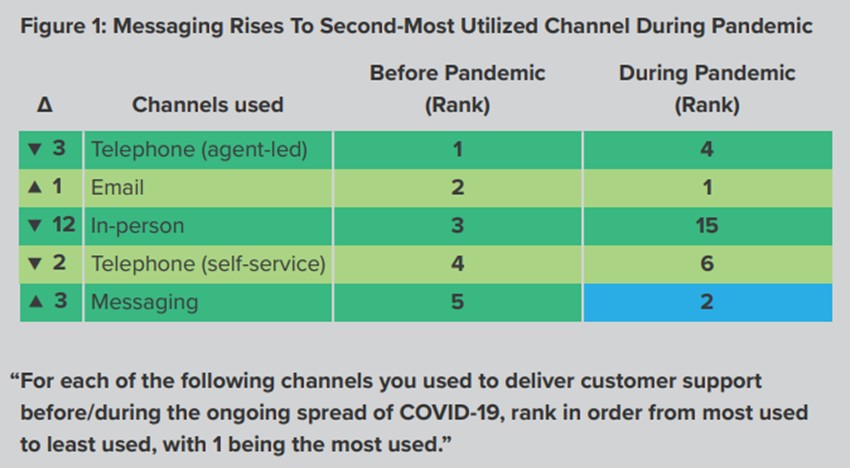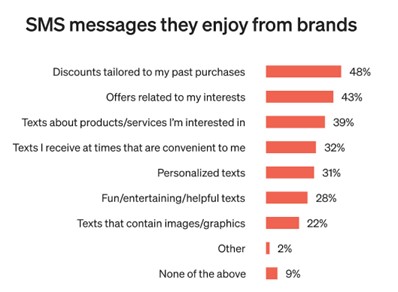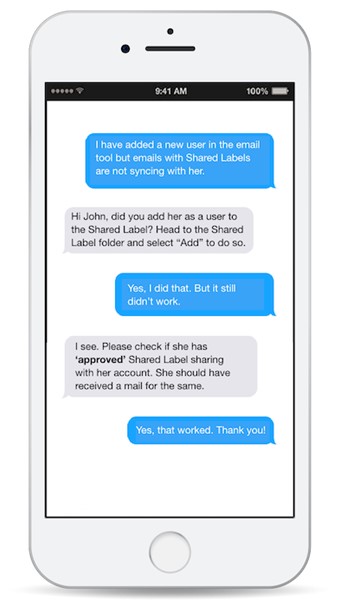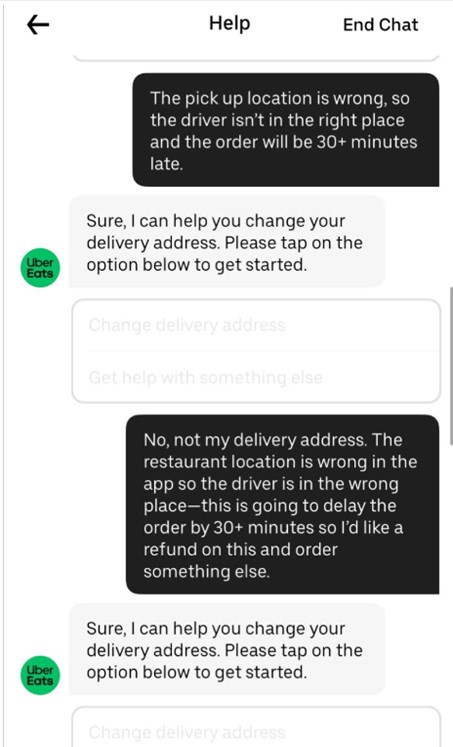SMS Customer Service: 8 Best Practices for Impressing Your Clients

Being there for your customers is always a high priority for your business. But being there when they urgently need your help? When they’re angry or upset?
It’s crucial.
But doing that using traditional customer service avenues is borderline impossible. We all know that our worst moments can happen at 3:00 AM.
Customers often don’t have the time or patience to wait for you to hop on a call with them, let alone wait the whole weekend for an email response. Don’t even get us started on in-person visits.
Sure, sometimes matters are so complex that you need a SWAT-type support team to resolve the issues.
But most of the time, speed and convenience determine the quality of service.
SMS customer service is fast, convenient, and lets you serve a large number of people at the same time, some of them even automatically!
So you better change your default tune to “who you gonna call text” and learn how to get the most out of your SMS customer support. 🎶👻
What Is SMS Customer Service?
Short messaging service (SMS) customer service is any sort of support that goes over SMS messages, including human help and chatbots alike. It includes both traditional texting and messaging apps, such as WhatsApp or Messenger.
It’s typically a part of an omnichannel customer support strategy alongside email, phone and video support, self-service, social media and the like.
Texting isn’t meant to replace all other types of support.
But with its undeniable speed and convenience, there are situations where no other channel can hold a candle to SMS customer service texting.
What Is SMS Customer Support Used For?
Here are some common SMS customer service use cases:
- Answer frequently asked questions
- Troubleshoot technical issues
- Handle customer complaints and problems
- Dispatch orders
- Provide quotes
- Communicate service updates, downtimes, and quick policy updates
- Receive customer feedback
- Follow up on previous customer service experiences
SMS customer support is a Cinderella fit for any situation where the exchange with the customer is short and straightforward and doesn’t require many steps or back-and-forth communication.
It’s also great for asynchronous yet efficient communication.
Customers can text you at their convenient times and receive support without having to schedule a call, wait on hold, or scour through your documentation.
Why is SMS Customer Support Important?
Great support is absolutely necessary because it can completely transform your customer experience and brand image. It’s part of the wider scope of customer relationship management (CRM), which is important for large and small businesses alike.
But why is SMS the way to go for customer service?
There are six crucial reasons.
1. Consumer Demand
To start with the obvious: SMS customer service is what your customers want.
Thousands of people own and use cell phones as their preferred method of communication.
This includes communication with brands – 93% of people want to text and talk with local businesses.
Calls and in-person support have drastically dropped since the pandemic started, while messaging rose from fifth place to be the second most used channel for customer support in 2021, right behind email.
Today, consumers are almost twice as likely to prefer SMS for customer service over any other channel.
SMS customer support is no longer the future. It’s a very current demand.
You’re meeting demand by reaching customers on their preferred platform, and customer satisfaction and loyalty follow.
2. Conversational And Personalised Messages
Personalisation is another thing that used to be a competitive edge that’s not just table stakes.
You need to cater to your customers’ preferences, starting with reaching them on the right platform (see point #1) and using the right tone. Nobody wants stuffy, jargon-heavy messages.
Today, people speak to brands the same way they speak to their family and friends.
SMS customer support is naturally more conversational, which removes a communication barrier and allows you to focus on what’s really important: personal and relevant messaging.
Now, what does “personalised SMS” really mean to consumers?
Notice how consumers don’t stop at “offers” but fully expect “offers related to my interests.”
Considering how they regard excellent customer service as the most distinguished quality of their favourite brands, personalised SMS customer support is all the more important.
3. More Convenient Than Phone Calls And Emails
Ever notice how younger generations like Millennials and Gen Z avoid calls like the plague?
This goes both for making and receiving calls. Research shows that 75% of Millennials avoid phone calls because they’re time-consuming, and 81% feel anxious before summoning the nerve to make a call.
You can tell by looking at the sheer number of “this could have been a text or email” memes and reels.
What about emails? They’re not exactly convenient. The problem is you often have to wait ages for a response, regardless of how simple your question is.
This is crucial because the majority of consumers (75%) say that the ability to answer questions promptly and helpfully is the quality they appreciate most about their favourite brands.
That brings us to SMS customer support, which trumps all the alternatives in this regard:
- Almost no waiting
- Asynchronous, at customers’ convenience
- Quick interactions as most texts are read within minutes
- In-text resolution of simple questions
- More casual as customers can respond in their own time
- Reduced need for calls
- Avoided millennial phone call anguish
With a 160-character limit and the highest open rate of all, using SMS for customer service makes perfect sense.
4. Cost-Efficient
Calls soak up a lot of resources. They require a live agent to sit there and spend time talking to one customer at a time.
Each of these interactions last way longer than they would have over SMS. You can simply send a text and do other things while you wait for the customer to respond.
On top of that, you can automate a part of your SMS customer service and reach a lot more customers at once while spending less money and labour.
5. Easily Scalable
Your support needs to be stellar regardless of the number of customers. If your channels can’t keep up with the increasing number of inquiries, the door opens to problems:
- Decreased customer satisfaction and brand loyalty due to long waiting times
- Support reps are overwhelmed, risk burnout, and have higher turnover
- Need to hire and train new support reps and the related expenses
- Business stagnation because you’ve hit your roof
Automated text messaging means you can be there for 1000 customers without much more labour than you’d need for 50.
As your SMS service becomes more sophisticated over time, you can spot-treat issues and clear a portion of your support tickets without having to resort to human interactions or calls.
SMS customer support encourages business growth, mitigates related risks, and saves you resources.
6. Higher Team Productivity
Less time spent per customer when you reduce the need for calls is a major time and money saver per agent, especially when you automate part of your service.
Your team can get through more queries in the same amount of time.
They can focus on more complex inquiries instead of acting as human versions of the documentation your customers don’t have time to deal with or answering repetitive questions that could have been resolved via text automation.
There’s simply no reason why a live agent should have to answer “What are your work hours?” ever again – yes, even if it’s the holiday season.
They have more important things to do.
SMS makes your agents more efficient and gives them some time to catch a breath.
The 8 Best Practices to Provide Excellent SMS Customer Service
So, how do you do SMS customer service correctly?
Try these best practices to guarantee the best experience for your business and your customers.
Summary
The shorter version, if you’re in a hurry:
| Best practice | Explanation |
| Personalise messages |
|
| Balance automation with human conversation |
|
| Select the right SMS service |
|
| Collect customer feedback to improve your processes |
|
| Promote your SMS customer service and make it visible |
|
| Send timely messages |
|
| Train your agents on how to use your SMS platform |
|
| Integrate SMS with other channels |
|
Keep reading for examples and more details.
1. Personalise Your Messages
Never underestimate the power of personalised support.
Noting relevant data about your customers enables you to suggest things you know are in their best interest and send truly helpful customised texts.
Sure, you can offer generic advice. But you don’t want a generic customer experience and SMS ROI, right?
Instead, sweep them off their feet by combining your industry expertise with a deep understanding of their needs and giving them key pieces of information they didn’t even know they were missing.
2. Balance Automation With Human Conversation
Use chatbots to answer certain questions immediately and save you the cost of labour.
Basic questions don’t call for a human agent. We mean things like:
- “What’s my account status?”
- “How do I activate a new banking feature?”
- “Where is your new office located?”
Do yourself and your reps a favour by reserving real-time human conversations for when it’s actually necessary – like when the question is more complex and requires context comprehension.
If you go with automation, don’t forget to leave a “talk to an agent” or “call instead” option for situations when automation isn’t solving the issue to prevent situations like this:
When it comes to machine or human service, be clear about which one is happening.
You don’t want customers to feel fooled because they thought a human was talking to them, and then it turns out it was a machine.
3. Select The Right SMS Service
Perhaps a provider that offers incredible customer service themself… like Mr Messaging? 😉
We’re only half-joking – your service provider definitely needs to offer proper support. If you’re having issues on your end, how are you going to serve your customers?
Aside from that, you absolutely need text message automation and 2-way SMS.
This essential feature allows customers to text you in the first place, otherwise, SMS customer support wouldn’t be possible.
Another thing to consider is whether you’ll be using SMS for things other than support.
For example, transactional SMS messages pair with customer service like pancakes with Nutella.
They can help you serve customers proactively, so there’s less need for them to contact you.
For example, transactional SMS can include appointment reminders, delivery status reports, and payment confirmations – all things a customer might ask about if you don’t proactively inform them.
Using your SMS platform for more than strictly customer service adds to the impression that your communication with your customers is natural and conversational and not categorised into formal cut-and-dry categories.
If you want to run SMS marketing campaigns like those, your provider consideration should include three other important features:
4. Collect Customer Feedback To Improve Your Processes
Most feedback is constructive.
Positive feedback empowers you to find out exactly what’s going well. so you can repeat the recipe and keep up the good work.
Negative feedback, as much as nobody wants to receive it, is an opportunity to improve. So that’s still a good thing.
Listen. Carefully. See what changes you can make to do better, then get more feedback.
Taking your feedback seriously shows your commitment to improving your customer service.
This gives customers a reason to stick with you even in situations when they would otherwise jump ship, which often happens after a negative experience with support.
5. Promote Your Customer Service And Make It Visible
List SMS customer support on your website and mention it on other marketing channels, like at the end of your newsletter.
Market the service alongside other channels you’re offering and explain its benefits to customers – the speed and convenience being high on the list.
The idea is to make customers aware of every option they have and normalise communicating with you over SMS in general.
6. Send Timely Messages
Don’t let your customers wait for days before you respond to an urgent query, especially when you’ve just marketed SMS as a quick channel – that was the whole point.
Consider giving them an estimated time frame when they can expect a message. This is more specific and less frustrating because customers know what’s going on.
Of course, always fulfil your promises. Trust is easily lost!
To avoid wasting your characters on an estimation each time you send a message, you can list a few common situations and response times upfront at the beginning of the chat or anywhere you mention your SMS service.
But how do you decide on the right time to respond?
- Categorise incoming messages and prioritise urgent ones
- Decide which ones will be handled by automation or a chatbot and where you need humans
- Test how long your agents need for different types of inquiries
Questions that call for automated responses don’t take any time. You can highlight those and then add a statement that goes something like:
“For other inquiries, you can expect a response from a support rep within a few minutes.”
7. Train Your Agents On How To Use Your SMS Platform (And The Appropriate Voice To Use)
You need training to achieve consistency with the rest of your brand messaging and between different agents, so your company sounds and reacts the same regardless of who the customer is speaking to.
It’s also to keep you compliant.
You want each agent to know the important rules and regulations to protect your company and satisfy customers.
Stop texting as soon as they opt out, and don’t extend SMS consent to consent for other channels when the customer doesn’t explicitly allow it.
You might assume these best practices are obvious but don’t leave compliance up to chance.
8. Integrate SMS With Other Channels, Such As Your Help Desk Or Ticketing Platform
The point is to achieve a seamless customer experience.
Your company needs to act as a united front, not “forget” previous interactions because they were with another agent or via another service channel.
Combining SMS customer support with other channels gives you the bandwidth where you don’t have to sacrifice speed for in-depth guidance or human help for chatbots.
You can – and should – have it all.
This is the only way you can ensure that, no matter what your customers need, you’re able to meet and exceed their expectations.
Be There The Moment Customers Need You With SMS Customer Service:
Omnichannel support is definitely a great idea – but SMS should be included regardless of what other avenues you’re already using.
No other channel can claim to be as quick and convenient as SMS customer support.
SMS enables you to go through inquiries at lightning speed, especially when you find that perfect balance between human help and chatbots.
All you need to get started is a service provider that offers two way SMS, making it possible for your customers to text you.
If you have questions about building the most helpful SMS customer service platform out there, reach out to Mr Messaging! Word’s on the street that our own customer service is pretty darn good. 😉






